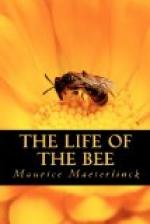Of wild bees approximately 4500 varieties are known. It need scarcely be said that we shall not go through the list. Some day, perhaps, a profound study, and searching experiments and observations of a kind hitherto unknown, that would demand more than one lifetime, will throw a decisive light upon the history of the bee’s evolution. All that we can do now is to enter this veiled region of supposition, and, discarding all positive statement, attempt to follow a tribe of hymenoptera in their progress towards a more intelligent existence, towards a little more security and comfort, lightly indicating the salient features of this ascension that is spread over many thousands of years. The tribe in question is already known to us; it is that of the “Apiens,” whose essential characteristics are so distinct and well-marked that one is inclined to credit all its members with one common ancestor.*
It is important that the terms we shall successively employ, adopting the classification of M. Emile Blanchard,—“APIENS, APIDAE and APITAE,—should not be confounded. The tribe of the Apiens comprises all families of bees. The Apidae constitute the first of these families, and are subdivided into three groups: the Meliponae, the Apitae, and the Bombi (humble-bees). And, finally, the Apitae include all the different varieties of our domestic bees.
The disciples of Darwin, Hermann Muller among others, consider a little wild bee, the Prosopis, which is to be found all over the universe, as the actual representative of the primitive bee whence all have issued that are known to us to-day.
The unfortunate Prosopis stands more or less in the same relation to the inhabitants of our hives as the cave-dwellers to the fortunate who live in our great cities. You will probably more than once have seen her fluttering about the bushes, in a deserted corner of your garden, without realising that you were carelessly watching the venerable ancestor to whom we probably owe most of our flowers and fruits (for it is actually estimated that more than a hundred thousand varieties of plants would disappear if the bees did not visit them) and possibly even our civilisation, for in these mysteries all things intertwine. She is nimble and attractive, the variety most common in France being elegantly marked with white on a black background. But this elegance hides an inconceivable poverty. She leads a life of starvation. She is almost naked, whereas her sisters are dad in a warm and sumptuous fleece. She has not, like the Apidae, baskets to gather the pollen, nor, in their default, the tuft of the Andrenae, nor the ventral brush of the Gastrilegidae. Her tiny claws must laboriously gather the powder from the calices, which powder she needs must swallow in order to take it back to her lair. She has no implements other than her tongue, her mouth and her claws; but her tongue is too short, her legs are feeble, and her mandibles without strength. Unable to produce wax, bore holes through wood, or dig in the earth, she contrives clumsy galleries in the tender pith of dry berries; erects a few awkward cells, stores these with a little food for the offspring she never will see; and then, having accomplished this poor task of hers, that tends she knows not whither and of whose aim we are no less ignorant, she goes off and dies in a corner, as solitarily as she had lived.




